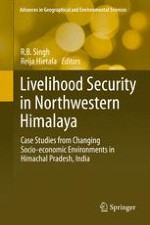This book identifies and analyzes livelihood impacts of recent environmental and socio-economic changes in urban and rural settings of the mountainous state of Himachal Pradesh, north western Himalaya, India. The findings of the research deal with the broader objectives of the changing patterns of agricultural production with special reference to diversification, as well as forest-based livelihood outcomes, Clean Development Mechanism forest project activities, the roles of different ethnic groups and non-governmental organizations and the benefits and shortcomings of tourism as a livelihood source. These tasks are studied by using an exploratory approach, with participant observation, interviews through random and cluster sampling among villagers, local land users and officials, as well as with land cover interpretation and secondary statistical data. This book is relevant for educational use together with policy input on the issues exploring livelihood security in a rapidly growing developing country.
